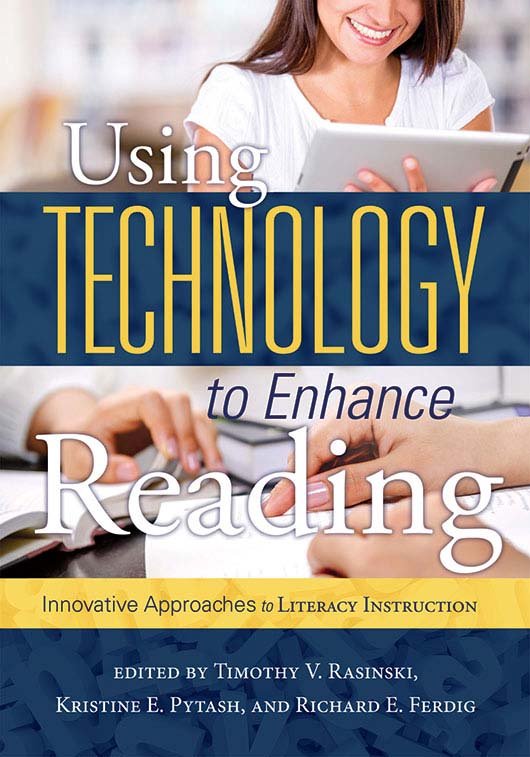Free Reproducibles
Using Technology to Enhance Reading
Innovative Approaches to Literacy Instruction
Enhance students’ reading abilities with technology. Discover how technological resources can improve the effectiveness and breadth of reading instruction to build student knowledge. Read real-world accounts from literacy experts, and learn how their methods can be adapted for your classroom. Explore how to foster improvement in student learning using a variety of tools, including interactive whiteboards, tablets, and social media applications.
Benefits
- Gain insight into ways to incorporate technology into reading instruction.
- Obtain guidance on choosing progress-monitoring tools to best address your students’ needs.
- Discover strategies to engage students in vocabulary instruction, and help students interpret informational texts.
- Learn how to use various tools to spark group discussions about literature.
- Determine how to continually assess students’ connections with the assigned reading material.
TABLE OF CONTENTS
Part I: Reading Foundations
Chapter 1: Foundational Reading Competencies Supported With Technology: Phonemic Awareness and Word Recognition
Chapter 2: Rethinking Foundational Reading Skills: Making Room for the Complexities of Digital Texts
Chapter 3: Using Tablets to Teach Foundational Skills: Matching Apps to Student Needs
Part II: Reading Fluency
Chapter 4: Podcasts: Adding Power and New Possibilities to the Readers Theater Experience
Chapter 5: Student-Produced Movies as Authentic Reading Fluency Instruction
Chapter 6: Audio-Assisted Reading Builds Reading Fluency
Part III: Reading Vocabulary
Chapter 7: Post-Reading Vocabulary Development Through VSSPlus
Chapter 8: Bringing Words to Life Through Student-Created Vocabulary Videos
Chapter 9: Self-Regulated Vocabulary Learning on the Internet
Part IV: Comprehension of Informational Texts
Chapter 10: Using the Multimodal Explanatory Composition Strategy to Respond to Informational Texts
Chapter 11: Annotation Apps: Supporting Middle School Students’ Interpretation of Science Texts
Chapter 12: Online Research and Media Skills: An Instructional Model for Online Informational Texts
Part V: Comprehension of Literary Texts
Chapter 13: Digging Deeper With Reader Response: Using Digital Tools to Support Comprehension of Literary Texts in Online Learning Environments
Chapter 14: Coding and Connecting Complex Literature
Chapter 15: Linking Through Literature: Exploring Complex Texts Through Hypertext Literary Analysis
Part VI: Reading Across Disciplines
Chapter 16: Classroom Blogging to Develop Disciplinary Literacy
Chapter 17: Using eReaders to Enhance Literacy Instruction in the Content Areas
Chapter 18: Supporting Inquiry With Digital Texts in School Disciplines
Part VII: Motivation for Reading
Chapter 19: "I Wanted to Film, So I Read the Book”: Filmmaking in the English Classroom
Chapter 20: eBooks and eReaders: Removing Obstacles, Improving Motivation
Chapter 21: Using Literacy iPad Apps for Reading Motivation
Part VIII: Reading Assessment
Chapter 22: Literacy Assessments in the Digital Age
Chapter 23: Developing and Assessing Fluency Through Web 2.0 Digital Tools
Chapter 24: Using Blogs as Formative Assessment of Reading Comprehension
REPRODUCIBLES
Chapter 3
- App Record Sheet
- Recommended Apps for Foundational Skills
- Tier 2 or Tier 3 Progress Monitoring Record for Letter Identification or Letter Sounds
Chapter 8
- Character Traits Word Web
- Generic Word Web
- Vocabulary Video Rubric
- Vocabulary Video Student Guide Sheet
Chapter 15
- Hypertext Literary Analysis Graphic Organizer
- Hypertext Literary Analysis Project Overview
- Sample Hypertext Literary Analysis Assignment Sheet
- Sample Hypertext Analysis Dialectical Journal Assignment
- Sample Hypertext Literary Analysis Project Overview
- Sample Hypertext Literary Analysis Rubric
Chapter 23
Chapter 24
SUGGESTED RESOURCES
Online Tutorials
- Add and play sounds in a presentation
- How to Add Hyperlinks to a PowerPoint Presentations for Dummies
- Vocabulary Self-Collection Strategy Plus (VSS+)
- Vocabulary Self-Collection Plus, Part 2
Websites
- Ambling Books
- Audacity
- BBC
- Blackboard
- Blogger
- Coming of Age Now
- Edublogs
- Edublogs, Curriculum Corner—Using Blogs With Students
- Ed.VoiceThread
- ePals
- Explain Everything
- FarFaria
- Folger Shakespeare Library
- Gizmo’s Freeware
- GlobalSchoolNet
- Glogster EDU
- Google Books
- Hypothesis
- Internet Archive
- iTunes
- Kidblog
- LibriVox
- Literacy Beat
- Lit Genius, "The Seventh Night” by Robert Hass
- Lit2Go
- Milk Monitor
- MixedInk
- Moodle
- NewHive
- Oklahoma Department of Libraries, A Century of Children’s Books, Part I
- Poetry4Kids
- PrimaryPad
- Project Gutenberg
- Readers Theater Podcasting
- Smore
- SoundBible
- Starfall
- Stonewashed
- Technology Integration Project
- ThingLink
- 2shared
- University of Texas at Dallas
- Vocabulary Self-Collection Strategy Plus Examples
- VoiceThread
- Weebly for Education

